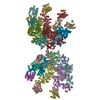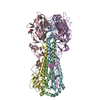[English] 日本語
 Yorodumi
Yorodumi- EMDB-5683: Molecular structure of the native influenza hemagglutinin H1 on v... -
+ Open data
Open data
- Basic information
Basic information
| Entry | Database: EMDB / ID: EMD-5683 | |||||||||
|---|---|---|---|---|---|---|---|---|---|---|
| Title | Molecular structure of the native influenza hemagglutinin H1 on virions | |||||||||
 Map data Map data | Reconstruction of hemagglutinin H1 from influenza virion (filamentous morphology) | |||||||||
 Sample Sample |
| |||||||||
 Keywords Keywords | hemagglutinin / cryoelectron microscopy / influenza vaccine / epitope | |||||||||
| Biological species |  Influenza A virus (A/California/07/2009(H1N1)) Influenza A virus (A/California/07/2009(H1N1)) | |||||||||
| Method | subtomogram averaging / cryo EM | |||||||||
 Authors Authors | Harris AK / Meyerson JR / Matsuoka Y / Kuybeda O / Moran A / Bliss D / Das SR / Yewdell JW / Sapiro G / Subbarao K / Subramaniam S | |||||||||
 Citation Citation |  Journal: Proc Natl Acad Sci U S A / Year: 2013 Journal: Proc Natl Acad Sci U S A / Year: 2013Title: Structure and accessibility of HA trimers on intact 2009 H1N1 pandemic influenza virus to stem region-specific neutralizing antibodies. Authors: Audray K Harris / Joel R Meyerson / Yumiko Matsuoka / Oleg Kuybeda / Amy Moran / Donald Bliss / Suman R Das / Jonathan W Yewdell / Guillermo Sapiro / Kanta Subbarao / Sriram Subramaniam /  Abstract: Rapid antigenic variation of HA, the major virion surface protein of influenza A virus, remains the principal challenge to the development of broader and more effective vaccines. Some regions of HA, ...Rapid antigenic variation of HA, the major virion surface protein of influenza A virus, remains the principal challenge to the development of broader and more effective vaccines. Some regions of HA, such as the stem region proximal to the viral membrane, are nevertheless highly conserved across strains and among most subtypes. A fundamental question in vaccine design is the extent to which HA stem regions on the surface of the virus are accessible to broadly neutralizing antibodies. Here we report 3D structures derived from cryoelectron tomography of HA on intact 2009 H1N1 pandemic virions in the presence and absence of the antibody C179, which neutralizes viruses expressing a broad range of HA subtypes, including H1, H2, H5, H6, and H9. By fitting previously derived crystallographic structures of trimeric HA into the density maps, we deduced the locations of the molecular surfaces of HA involved in interaction with C179. Using computational methods to distinguish individual unliganded HA trimers from those that have bound C179 antibody, we demonstrate that ∼75% of HA trimers on the surface of the virus have C179 bound to the stem domain. Thus, despite their close packing on the viral membrane, the majority of HA trimers on intact virions are available to bind anti-stem antibodies that target conserved HA epitopes, establishing the feasibility of universal influenza vaccines that elicit such antibodies. | |||||||||
| History |
|
- Structure visualization
Structure visualization
| Movie |
 Movie viewer Movie viewer |
|---|---|
| Structure viewer | EM map:  SurfView SurfView Molmil Molmil Jmol/JSmol Jmol/JSmol |
| Supplemental images |
- Downloads & links
Downloads & links
-EMDB archive
| Map data |  emd_5683.map.gz emd_5683.map.gz | 521.6 KB |  EMDB map data format EMDB map data format | |
|---|---|---|---|---|
| Header (meta data) |  emd-5683-v30.xml emd-5683-v30.xml emd-5683.xml emd-5683.xml | 9.4 KB 9.4 KB | Display Display |  EMDB header EMDB header |
| Images |  emd_5683_1.jpg emd_5683_1.jpg | 60.2 KB | ||
| Archive directory |  http://ftp.pdbj.org/pub/emdb/structures/EMD-5683 http://ftp.pdbj.org/pub/emdb/structures/EMD-5683 ftp://ftp.pdbj.org/pub/emdb/structures/EMD-5683 ftp://ftp.pdbj.org/pub/emdb/structures/EMD-5683 | HTTPS FTP |
-Validation report
| Summary document |  emd_5683_validation.pdf.gz emd_5683_validation.pdf.gz | 78.9 KB | Display |  EMDB validaton report EMDB validaton report |
|---|---|---|---|---|
| Full document |  emd_5683_full_validation.pdf.gz emd_5683_full_validation.pdf.gz | 78 KB | Display | |
| Data in XML |  emd_5683_validation.xml.gz emd_5683_validation.xml.gz | 499 B | Display | |
| Arichive directory |  https://ftp.pdbj.org/pub/emdb/validation_reports/EMD-5683 https://ftp.pdbj.org/pub/emdb/validation_reports/EMD-5683 ftp://ftp.pdbj.org/pub/emdb/validation_reports/EMD-5683 ftp://ftp.pdbj.org/pub/emdb/validation_reports/EMD-5683 | HTTPS FTP |
-Related structure data
- Links
Links
| EMDB pages |  EMDB (EBI/PDBe) / EMDB (EBI/PDBe) /  EMDataResource EMDataResource |
|---|
- Map
Map
| File |  Download / File: emd_5683.map.gz / Format: CCP4 / Size: 659.2 KB / Type: IMAGE STORED AS FLOATING POINT NUMBER (4 BYTES) Download / File: emd_5683.map.gz / Format: CCP4 / Size: 659.2 KB / Type: IMAGE STORED AS FLOATING POINT NUMBER (4 BYTES) | ||||||||||||||||||||||||||||||||||||||||||||||||||||||||||||||||||||
|---|---|---|---|---|---|---|---|---|---|---|---|---|---|---|---|---|---|---|---|---|---|---|---|---|---|---|---|---|---|---|---|---|---|---|---|---|---|---|---|---|---|---|---|---|---|---|---|---|---|---|---|---|---|---|---|---|---|---|---|---|---|---|---|---|---|---|---|---|---|
| Annotation | Reconstruction of hemagglutinin H1 from influenza virion (filamentous morphology) | ||||||||||||||||||||||||||||||||||||||||||||||||||||||||||||||||||||
| Projections & slices | Image control
Images are generated by Spider. generated in cubic-lattice coordinate | ||||||||||||||||||||||||||||||||||||||||||||||||||||||||||||||||||||
| Voxel size | X=Y=Z: 4.1 Å | ||||||||||||||||||||||||||||||||||||||||||||||||||||||||||||||||||||
| Density |
| ||||||||||||||||||||||||||||||||||||||||||||||||||||||||||||||||||||
| Symmetry | Space group: 1 | ||||||||||||||||||||||||||||||||||||||||||||||||||||||||||||||||||||
| Details | EMDB XML:
CCP4 map header:
| ||||||||||||||||||||||||||||||||||||||||||||||||||||||||||||||||||||
-Supplemental data
- Sample components
Sample components
-Entire : H1 hemagglutinin A/California/7/2009 (H1N1)
| Entire | Name: H1 hemagglutinin A/California/7/2009 (H1N1) |
|---|---|
| Components |
|
-Supramolecule #1000: H1 hemagglutinin A/California/7/2009 (H1N1)
| Supramolecule | Name: H1 hemagglutinin A/California/7/2009 (H1N1) / type: sample / ID: 1000 / Oligomeric state: trimer / Number unique components: 2 |
|---|
-Macromolecule #1: influenza envelope glycoprotein hemagglutinin (HA)
| Macromolecule | Name: influenza envelope glycoprotein hemagglutinin (HA) / type: protein_or_peptide / ID: 1 / Name.synonym: influenza surface spike / Recombinant expression: No / Database: NCBI |
|---|---|
| Source (natural) | Organism:  Influenza A virus (A/California/07/2009(H1N1)) Influenza A virus (A/California/07/2009(H1N1)) |
-Experimental details
-Structure determination
| Method | cryo EM |
|---|---|
 Processing Processing | subtomogram averaging |
| Aggregation state | particle |
- Sample preparation
Sample preparation
| Buffer | pH: 7.4 / Details: PBS buffer |
|---|---|
| Grid | Details: Quantifoil Multi-A, 200 mesh |
| Vitrification | Cryogen name: ETHANE / Instrument: FEI VITROBOT MARK IV |
- Electron microscopy
Electron microscopy
| Microscope | FEI POLARA 300 |
|---|---|
| Specialist optics | Energy filter - Name: Gatan / Energy filter - Lower energy threshold: 0.0 eV / Energy filter - Upper energy threshold: 20.0 eV |
| Date | Sep 6, 2010 |
| Image recording | Category: CCD / Film or detector model: GENERIC CCD / Average electron dose: 100 e/Å2 |
| Electron beam | Acceleration voltage: 200 kV / Electron source:  FIELD EMISSION GUN FIELD EMISSION GUN |
| Electron optics | Illumination mode: FLOOD BEAM / Imaging mode: BRIGHT FIELD / Nominal defocus max: 2.5 µm / Nominal defocus min: 2.5 µm / Nominal magnification: 34000 |
| Sample stage | Specimen holder model: GATAN LIQUID NITROGEN / Tilt series - Axis1 - Min angle: -60 ° / Tilt series - Axis1 - Max angle: 60 ° |
| Experimental equipment |  Model: Tecnai Polara / Image courtesy: FEI Company |
- Image processing
Image processing
| Details | Average number of tilts used in the 3D reconstructions: 61. Average tomographic tilt angle increment: 2. |
|---|---|
| Final reconstruction | Software - Name:  IMOD / Number subtomograms used: 416 IMOD / Number subtomograms used: 416 |
-Atomic model buiding 1
| Initial model | PDB ID: |
|---|---|
| Refinement | Space: REAL / Protocol: RIGID BODY FIT |
 Movie
Movie Controller
Controller















 Z (Sec.)
Z (Sec.) Y (Row.)
Y (Row.) X (Col.)
X (Col.)






















